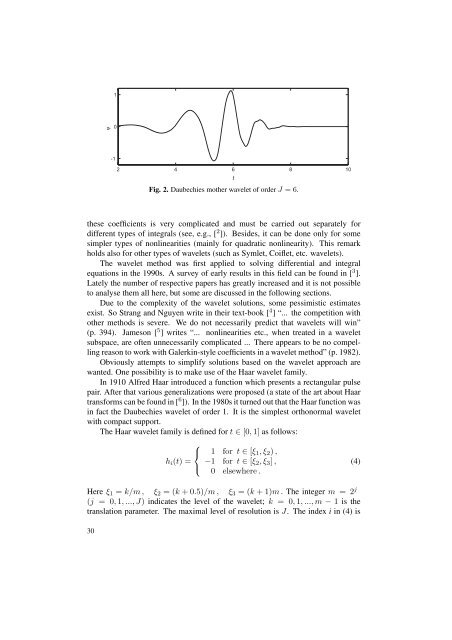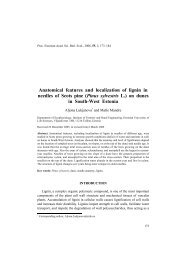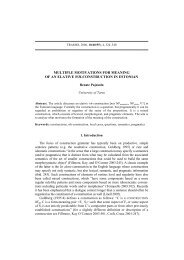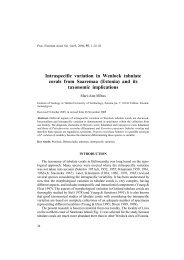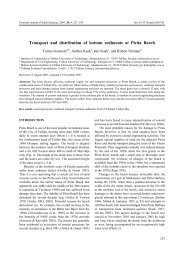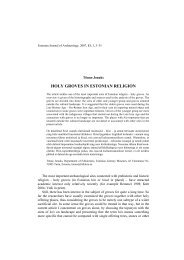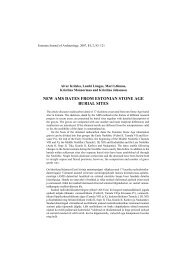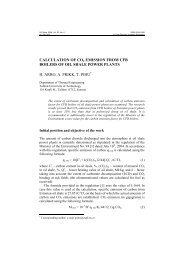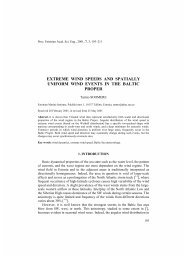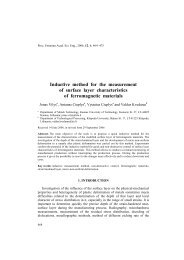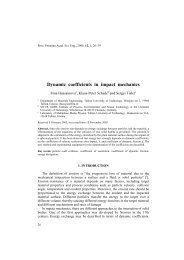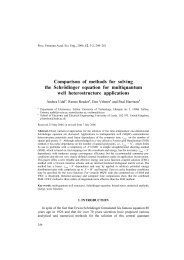Application of the Haar wavelet transform to solving integral and ...
Application of the Haar wavelet transform to solving integral and ...
Application of the Haar wavelet transform to solving integral and ...
Create successful ePaper yourself
Turn your PDF publications into a flip-book with our unique Google optimized e-Paper software.
1<br />
ψ<br />
0<br />
-1<br />
2 4 6 8 10<br />
t<br />
Fig. 2. Daubechies mo<strong>the</strong>r <strong>wavelet</strong> <strong>of</strong> order J = 6.<br />
<strong>the</strong>se coefficients is very complicated <strong>and</strong> must be carried out separately for<br />
different types <strong>of</strong> <strong>integral</strong>s (see, e.g., [ 2 ]). Besides, it can be done only for some<br />
simpler types <strong>of</strong> nonlinearities (mainly for quadratic nonlinearity). This remark<br />
holds also for o<strong>the</strong>r types <strong>of</strong> <strong>wavelet</strong>s (such as Symlet, Coiflet, etc. <strong>wavelet</strong>s).<br />
The <strong>wavelet</strong> method was first applied <strong>to</strong> <strong>solving</strong> differential <strong>and</strong> <strong>integral</strong><br />
equations in <strong>the</strong> 1990s. A survey <strong>of</strong> early results in this field can be found in [ 3 ].<br />
Lately <strong>the</strong> number <strong>of</strong> respective papers has greatly increased <strong>and</strong> it is not possible<br />
<strong>to</strong> analyse <strong>the</strong>m all here, but some are discussed in <strong>the</strong> following sections.<br />
Due <strong>to</strong> <strong>the</strong> complexity <strong>of</strong> <strong>the</strong> <strong>wavelet</strong> solutions, some pessimistic estimates<br />
exist. So Strang <strong>and</strong> Nguyen write in <strong>the</strong>ir text-book [ 4 ] “... <strong>the</strong> competition with<br />
o<strong>the</strong>r methods is severe. We do not necessarily predict that <strong>wavelet</strong>s will win”<br />
(p. 394). Jameson [ 5 ] writes “... nonlinearities etc., when treated in a <strong>wavelet</strong><br />
subspace, are <strong>of</strong>ten unnecessarily complicated ... There appears <strong>to</strong> be no compelling<br />
reason <strong>to</strong> work with Galerkin-style coefficients in a <strong>wavelet</strong> method” (p. 1982).<br />
Obviously attempts <strong>to</strong> simplify solutions based on <strong>the</strong> <strong>wavelet</strong> approach are<br />
wanted. One possibility is <strong>to</strong> make use <strong>of</strong> <strong>the</strong> <strong>Haar</strong> <strong>wavelet</strong> family.<br />
In 1910 Alfred <strong>Haar</strong> introduced a function which presents a rectangular pulse<br />
pair. After that various generalizations were proposed (a state <strong>of</strong> <strong>the</strong> art about <strong>Haar</strong><br />
<strong>transform</strong>s can be found in [ 6 ]). In <strong>the</strong> 1980s it turned out that <strong>the</strong> <strong>Haar</strong> function was<br />
in fact <strong>the</strong> Daubechies <strong>wavelet</strong> <strong>of</strong> order 1. It is <strong>the</strong> simplest orthonormal <strong>wavelet</strong><br />
with compact support.<br />
The <strong>Haar</strong> <strong>wavelet</strong> family is defined for t ∈ [0, 1] as follows:<br />
⎧<br />
⎨ 1 for t ∈ [ξ 1 , ξ 2 ) ,<br />
h i (t) = −1 for t ∈ [ξ 2 , ξ 3 ] ,<br />
⎩<br />
0 elsewhere .<br />
Here ξ 1 = k/m , ξ 2 = (k + 0.5)/m , ξ 3 = (k + 1)m . The integer m = 2 j<br />
(j = 0, 1, ..., J) indicates <strong>the</strong> level <strong>of</strong> <strong>the</strong> <strong>wavelet</strong>; k = 0, 1, ..., m − 1 is <strong>the</strong><br />
translation parameter. The maximal level <strong>of</strong> resolution is J. The index i in (4) is<br />
(4)<br />
30


